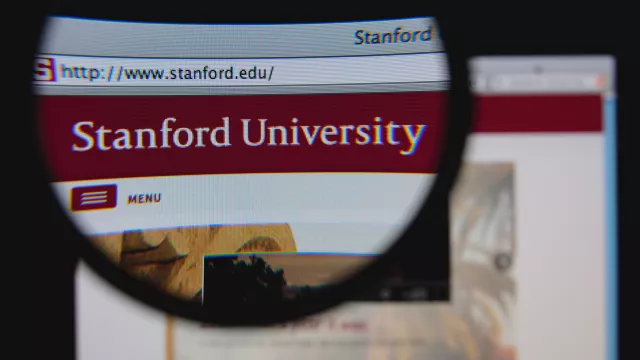Table of Contents
Approaching challenging ideas with resilience, not fear

Shutterstock.com
What is “harm”?
Depending on the source you consult, you might say a “physical injury,” “physical or mental damage,” or “a deliberate injury or damage to someone or something.”
In other words, “harm” is a broad category that, without context, means little more than “negative impact.”
You’re sure to encounter the term used in vague and overbroad ways in college and university policies and public statements. Perhaps most famously, the Stanford University IT department’s “Elimination of Harmful Language Initiative” — which the school has since walked back — designated hundreds of words as “harmful,” including “American,” “submit,” “walk-in,” and “grandfather.”
Judging by the sheer number and range of words on Stanford’s list, it’s clear that some administrators believe harm is everywhere — that it can strike at any moment or place.
But there’s something futile about labeling individual words “harmful,” because a word’s meaning and emotional impact emerge through context — both that of the words surrounding it and of a hearer’s personal experience. Even a simple sentence like, “See Spot run,” might trigger feelings of harm in someone who once lost a dog named Spot but ignite warm feelings in someone who recalls a favorite childhood movie.
Casting words with neutral or ambiguous connotations as harmful may invite rather than alleviate discomfort not only by alienating those who don’t relate, but also by expanding the range of language perceived as dangerous or damaging.
Likewise, someone who has no strong reaction to the phrase “rule of thumb” may not readily assign it the emotional weight of domestic abuse simply because a language initiative draws that tenuous connection.
Yet suggesting people refrain from using words that might provoke discomfort is often framed as a recipe for inclusion.
As Stanford Chief Information Officer Steve Gallagher wrote about the language initiative: “The primary motivation of this initiative was always to promote a more inclusive and welcoming environment where individuals from all backgrounds feel they belong.” But the intense backlash following its publication forced Gallagher to realize it had the opposite effect. “The feedback that this work was broadly viewed as counter to inclusivity means we missed the intended mark,” he acknowledged.
Maybe one reason the list elicited such negative responses is that it ignored the subjective experience of everyone who doesn’t relate to the narrow associations the list ascribed to words. To use the language du jour on many campuses, it felt “othering.”
A fear-based cycle
Casting words with neutral or ambiguous connotations as harmful may invite rather than alleviate discomfort not only by alienating those who don’t relate, but also by expanding the range of language perceived as dangerous or damaging. In other words, encouraged to anticipate harm, people may be more likely to perceive harm.
This fear-based cycle can apply not only to words or phrases, but also ideas and people. When it does, people may justify using illiberal tactics to shut down others’ speech, believing they’re protecting themselves and others from genuine harm. Unfortunately, this has the effect of raising the temperature of the room, making communication more difficult.
That’s what happened at Stanford in mid-March, when Stanford Law School’s student chapter of the Federalist Society invited Trump-appointed U.S. Court of Appeals Judge Kyle Duncan to speak at a FedSoc-sponsored event.

Stanford University: Law Students, Administrator Disrupt Federalist Society Event Featuring 5th Circuit Judge
FIRE wrote Stanford after a Fifth Circuit Judge Stuart Kyle Duncan attempted to speak at a Federalist Society-organized event when dozens of protesters heckled him, preventing him from finishing his remarks.
Reacting to sentiments of student activists who objected to Judge Duncan’s views and wanted the event canceled, Stanford’s associate dean for diversity, equity, and inclusion, Tirien Steinbach, emailed the law school student body the morning of the event, sympathizing with the activists’ concerns. And while she did not cave to their demand, her email stoked students’ fears, telling them “the event would be a ‘significant hit’ to [their] sense of belonging.”
At the event, student protesters behaved predictably. Acting as if Duncan’s mere presence posed a threat, they substantially disrupted him so he couldn’t deliver his remarks. Steinbach then added fuel to the fire: Taking the podium with a prepared statement, she ultimately wondered aloud whether “rethinking” Stanford’s free speech protections might be in order, and asked Duncan if the “juice” (what he came to say) is “worth the squeeze” (students’ feelings of pain and division).
Needless to say, Steinbach’s remarks and the students’ continued heckling didn’t improve the quality of discourse. The disruptions continued, the event ended early, and the controversy around it persisted for weeks.
Embracing agency
Perhaps higher ed leaders can help more students feel comfortable by choosing not to frame words, concepts, and people as unduly threatening, instead giving space to a wide range of student associations and responses. Further, administrators and instructors can explicitly set the precedent that free expression is the campus norm — and that that goes for everyone, no matter their views.
Stanford Law School Dean Jenny Martinez made that clear in a statement to the Stanford Law School community following the shoutdown of Judge Duncan. Her statement leaned on Stanford’s strong speech-protective policies, affirming the right of students to hear speakers and of protestors to non-disruptively express opposition. The beauty of this message is it neither stokes fear nor assumes uniform emotional reactions to particular words, ideas, or people. And it clarifies the expectations that accompany being part of an academic community, giving students the opportunity to decide whether, when, and how to participate.
Students, for their part, should know there is an alternative to shutting down speech — one that improves their chances of limiting the reach of ideas with which they disagree. It starts with meeting challenging ideas with resilience. It ends with convincing people of the merits of one’s arguments.
The sort of resilience I’m describing isn’t about dismissing the power of ideas to evoke negative feelings. Nor is it about simply gritting our teeth when we feel threatened. To the contrary, it entails accepting the reality that a troubling idea exists — regardless of whether we stifle it in one place and time — and getting curious about our emotional response to it. This can enable us to truly hear, examine, and, finally, effectively confront it.
Placing more of the onus of mitigating the negative emotional impact of speech on the listener than the speaker may seem counterintuitive in the face of speech we consider vile, but it’s the only way to ensure we can express our own views. And it’s far more empowering than the alternative.
This path affirms that individuals have agency to decide how to respond to the challenging ideas they’ll inevitably encounter in life. The opposite view suggests an individual’s comfort depends on others’ willingness to bend their expression to his or her whims. This creates discomfort for everyone involved: The sheltered individual, when a disturbing idea inevitably slips through the cracks, and everyone else, whose expression is stifled for the individual’s comfort.
By believing we possess some ability to react constructively to that which upsets us, we can acknowledge that words can perturb, provoke, and offend without granting them inordinate ability to damage our core being. Further, we can recognize the power of our own words and use them to refute convincingly arguments we find disturbing or hateful — through conversation, debate, or peaceful protest.
Language is a tool that enables us to engage in conflict without incapacitating those with whom we disagree. Inasmuch as it serves this function, it alleviates more harm than it perpetuates and fosters more inclusion than it prevents.
In light of this, we might come to see intense conversations not as a threat, but as a promise.
Recent Articles
Get the latest free speech news and analysis from FIRE.

VICTORY: Court vindicates professor investigated for parodying university’s ‘land acknowledgment’ on syllabus

Can the government ban controversial public holiday displays?

DOJ plan to target ‘domestic terrorists’ risks chilling speech



